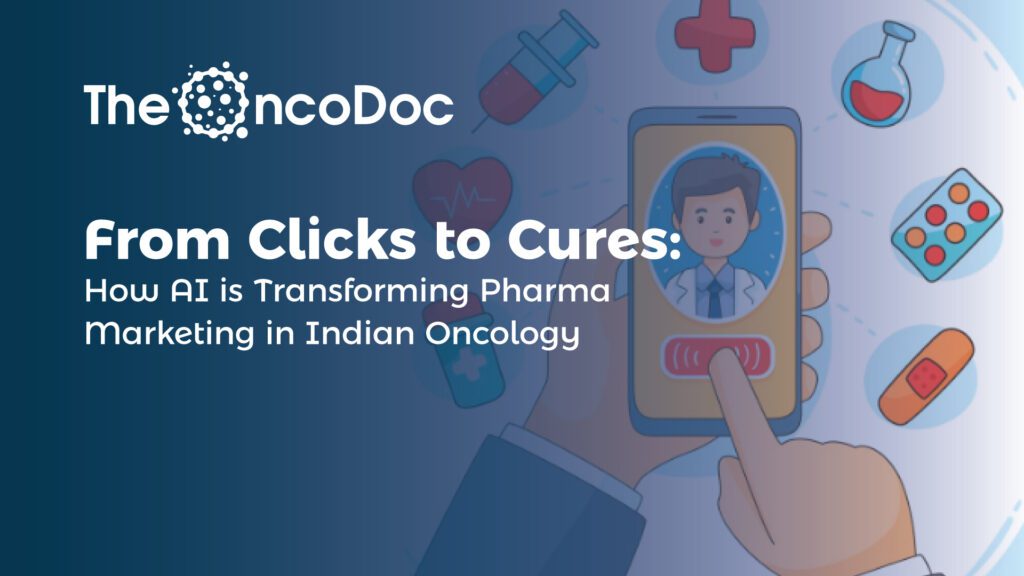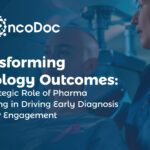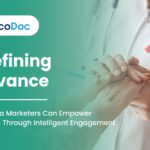Introduction: Beyond Treatment Promotion to Predictive Healthcare
In India’s evolving healthcare ecosystem, oncology is witnessing a pivotal shift. With more than 1.5 million new cancer cases diagnosed annually and nearly 70% presenting at late stages, the need for proactive intervention is urgent. Traditionally, pharmaceutical marketing in oncology has centered around promoting therapeutic products to specialists. However, the emergence of Artificial Intelligence (AI) has redefined what pharma marketers can and should do.
AI is not just a buzzword, it is a game-changer in delivering predictive insights, personalizing content, and optimizing campaigns across patient and physician journeys. From symptom awareness to referral support and from HCP segmentation to behavioral nudges, AI is enabling pharma brands to position themselves not just as treatment providers but as partners in care transformation.
This article explores how AI is revolutionizing pharma marketing in Indian oncology, backed by data, examples, and digital strategies designed for impact.
Section 1: Why Indian Oncology Needs an AI-Led Marketing Rethink
India’s cancer burden is growing at an alarming rate, compounded by systemic issues like low awareness, inadequate screening infrastructure, and referral delays.
Key Challenges in Current Oncology Pathways:
- Late diagnosis: Over 70% of cancers are diagnosed in Stage III or IV.
- Urban-rural disparity: 60% of oncology infrastructure is concentrated in top-tier cities.
- Low GP-to-oncologist referrals: General practitioners (GPs) often lack symptom-specific knowledge and digital referral tools.
Enter AI-Powered Pharma Marketing
AI provides an opportunity to:
- Detect patterns in patient behaviors.
- Predict HCP engagement preferences.
- Automate regional targeting based on risk models.
- Personalize education and content delivery.
Pharma brands must pivot their digital strategy from “product-centric” to “proactive care enablement.”
Section 2: AI-Driven Risk Stratification; Who to Reach and When
Identifying high-risk populations is foundational to any successful cancer prevention or early detection initiative. AI allows pharma marketers to do this with surgical precision.
How It Works:
- Geo-spatial risk modeling: AI platforms can analyze regional cancer incidence data, pollution levels, and tobacco usage patterns to identify high-risk zones.
- Demographic targeting: AI algorithms evaluate population subsets based on age, gender, lifestyle, and diet to predict vulnerability.
- Behavioral search signals: Platforms like Google Trends are now being mined for increased search terms like “persistent cough,” “breast lump,” or “blood in stool.”
Such stratification allows pharma campaigns to prioritize regions and communities with the highest impact potential.
Section 3: Hyper-Personalized Physician Engagement
Gone are the days of generic email campaigns or static HCP portals. AI enables pharma marketers to customize touchpoints based on physician behavior, specialty, and content interaction history.
AI Capabilities for HCP Personalization:
- Dynamic Content Engines: Serve different formats (videos, research papers, CME invites) based on HCP preferences.
- Predictive Engagement Models: Use previous interaction metrics to forecast open/click rates and adapt outreach.
- Referral Probability Algorithms: Identify GPs with a history of late referrals and deploy nudges via WhatsApp or Telegram.
This level of targeting boosts engagement rates while minimizing campaign fatigue.
Section 4: Predictive Referral Pathway Management Using AI Dashboards
The Need:
Delayed referrals remain one of the largest contributors to late-stage cancer diagnosis in India. AI-driven referral management tools now allow pharma brands to play a facilitative role.
Features of AI Referral Dashboards:
- Real-Time Triage Alerts: Flag GPs who encounter high-risk patients.
- Referral Completion Tracking: Identify drop-offs in the diagnosis pipeline.
- Smart Reminders: Automate WhatsApp follow-ups to referring doctors.
By identifying and acting on such gaps, pharma brands can position themselves as ecosystem enablers.
Section 5: AI-Powered Chatbots for Symptom Awareness and Navigation
AI-powered chatbots are evolving into vital tools for oncology outreach. Beyond basic support, they now help guide patients through symptom self-assessment, provide tailored educational content, and facilitate access to diagnostic services, all in real time.
Key Features:
- Multilingual Support: Chatbots operate in over 10 Indian languages, ensuring inclusivity across diverse populations.
- Symptom-Based Guidance: Based on user inputs, they recommend next steps, from seeing a general physician to locating the nearest cancer screening center.
- CRM Integration: All interactions are logged and analyzed, enabling pharma teams to refine messaging, follow up intelligently, and measure campaign impact.
These AI-driven interfaces are especially impactful in Tier 2 and Tier 3 cities, where awareness is limited but smartphone usage is rising. By making cancer education conversational and accessible, chatbots empower individuals to take timely action, closing critical gaps in early diagnosis and referral.
Section 6: Measuring What Matters; Real-Time Optimization with AI Analytics
In today’s fast-moving digital landscape, pharma marketers can no longer rely on retrospective campaign reports to make decisions. AI-powered analytics enable real-time performance tracking, allowing marketers to refine oncology campaigns while they’re live, maximizing both efficiency and impact.
Key Metrics to Monitor:
- Engagement heatmaps by geography: Understand which regions are responding most actively to campaigns and adjust targeting accordingly.
- Time-to-click by HCP type: Gauge how quickly oncologists, GPs, or specialists engage with different content formats.
- Symptom-checker tool conversions: Track how many users go from viewing to completing screening prompts.
- Referral asset usage rates: Monitor the ratio of referral form downloads to actual referral submissions.
Insights That Drive Action:
- A/B testing at scale: AI can automatically test different headlines, creatives, or formats and optimize for what performs best.
- Smart content timing: Analyze when different HCP segments are most active and schedule pushes to match their digital routines.
- Dynamic geo-retargeting: Use low-performing zones as a signal to refresh creative assets or redistribute spend more effectively.
With AI at the helm, pharma marketing evolves from static planning to adaptive execution. Campaigns no longer follow a fixed timeline, they shift dynamically based on what’s working and where. This data-driven agility ensures that oncology messages reach the right audience, in the right format, at the right moment, turning insight into intervention.
Section 7: AI-Driven Influencer Campaigns for Deeper Community Impact
In oncology marketing, trust is everything, and patients are far more likely to engage with relatable human stories than corporate messaging. Influencer-led campaigns featuring cancer survivors, caregivers, and regional health advocates can significantly amplify reach and emotional resonance. With Artificial Intelligence, these campaigns can now be precisely targeted, personalized, and performance-optimized.
Here’s how AI enhances influencer strategy:
- Sentiment Mapping through NLP: Natural Language Processing (NLP) tools can scan social media platforms to understand public sentiment around cancer-related topics. This helps marketers gauge emotional triggers, misinformation trends, and content gaps, ensuring influencer messaging is aligned with audience concerns.
- Micro-Influencer Identification: AI can analyze follower demographics, engagement metrics, and content relevance to identify micro-influencers with strong community trust, especially in local or regional settings. These voices often outperform mainstream celebrities in terms of impact and authenticity.
- Smart Content Distribution: Once influencers are onboarded, AI algorithms automate when, where, and how content should be pushed, based on historical performance, audience behavior, and platform dynamics. This ensures maximum reach with minimal noise.
By blending emotional storytelling with AI precision, pharma brands can create campaigns that don’t just inform, they inspire. These initiatives cultivate community dialogue, normalize early diagnosis, and shift behaviors from delay to action. In the complex terrain of cancer care, such emotionally intelligent, data-informed marketing can be a powerful catalyst for change.
Section 8: AI in Multistakeholder Collaboration
Scaling AI-powered oncology marketing initiatives requires strategic collaboration across the healthcare ecosystem. Pharma brands alone cannot drive systemic change, they must act as connectors, bringing together multiple stakeholders to ensure that technology reaches the right people at the right time.
Key partnerships include:
- NGOs for Grassroots Mobilization: Non-governmental organizations play a crucial role in community outreach, especially in Tier 2 and Tier 3 regions. By working with NGOs, pharma brands can deploy AI-driven tools like symptom checkers, chatbots, and screening reminders in local languages, ensuring cultural relevance and wider adoption.
- Government Bodies for Data and Scale: Integration with national programs such as the Ayushman Bharat Digital Mission (ABDM) enables seamless data-sharing and access to Personal Health Records (PHRs). Collaborating with district health authorities allows pharma campaigns to plug into existing public health infrastructure, extending the reach and credibility of AI tools.
- Hospitals and Clinics for Pilot Execution: Private and public healthcare institutions are ideal environments to test AI dashboards, referral systems, and predictive tools. By embedding these into real clinical workflows, pharma brands can generate evidence, improve referral behavior, and refine user experiences.
AI dashboards and analytics should be shared across these stakeholders to unify insights and streamline actions. Such collaboration ensures that digital marketing evolves into a holistic care enabler, driving early detection, improving patient pathways, and accelerating impact across the cancer care continuum.
Section 9: Mini Case – AI Referral Campaign in Uttar Pradesh (2024)
Objective:
Reduce Stage IV presentation in breast and cervical cancers by driving earlier referrals.
Strategy:
- Used AI to identify 10 districts with highest late-stage diagnosis rates.
- Sent WhatsApp chatbot links to 15,000 GPs and ASHA workers.
- Auto-shared nearby diagnostic centers based on geo-location.
Results:
- 92,000+ chatbot interactions
- 1,200+ HCPs downloaded referral tools
- 28% increase in early-stage diagnoses in targeted areas (as per SGPGI Lucknow report)
This case shows that when AI meets execution, public health outcomes improve dramatically.
Section 10: Future-Forward; Where AI and Oncology Marketing Is Headed
As AI continues to evolve, its integration with oncology pharma marketing will become increasingly sophisticated, paving the way for more personalized, accessible, and outcome-driven strategies. The next phase of this transformation will see the convergence of multiple technologies and data sources, enabling pharma brands to go beyond awareness and engagement, to actively shaping cancer care delivery.
Here’s how the future is unfolding:
- AI + AR for Virtual Clinics: The combination of Artificial Intelligence and Augmented Reality will redefine patient interactions. AI-powered chatbots can pre-screen symptoms, while AR simulations will enable remote consultations with oncologists. This will be especially impactful in rural and underserved areas, bridging specialist access gaps and offering immersive, guided health experiences.
- PHR Integration with National Health Stack: AI tools linked with Ayushman Bharat Digital Mission (ABDM) and Personal Health Records (PHRs) will unlock hyper-personalized patient engagement. These systems can identify high-risk individuals, track care gaps, and trigger timely reminders for screenings, tests, or consultations, tailored to the patient’s history and risk profile.
- Predictive Inventory and Diagnostic Planning: AI will revolutionize how pharma brands support supply chain efficiency. Using real-time engagement data from campaigns, AI models can predict where the demand for diagnostic kits, screening tools, or oncology referrals will spike. This allows better coordination with hospitals, diagnostic centers, and health departments.
In short, the future of AI in oncology marketing is not just about smarter communication, it’s about proactive, system-level enablement. The pharma industry stands at the cusp of becoming a key orchestrator of connected, equitable, and predictive cancer care in India.
Conclusion: Redefining Pharma’s Role in the Oncology Ecosystem
Artificial Intelligence is not only transforming how pharma marketing operates, it is redefining its very purpose. In oncology, where every delay can cost a life, AI offers marketers a powerful way to influence outcomes by enabling early detection, timely referrals, and informed decision-making.
Pharma’s role must now evolve from being product promoters to becoming meaningful partners in the healthcare continuum. This means designing campaigns that don’t just inform, but intervene, campaigns that engage both HCPs and patients at critical moments in their journey.
It’s time to shift focus:
- From pushing products to pulling communities into earlier, smarter care.
- From siloed selling to collaborating with public health systems and care pathways.
- From measuring ROI in prescriptions to tracking improvements in stage-at-diagnosis and patient outcomes.
As the Indian oncology landscape becomes more data-driven and patient-centric, success in pharma marketing will no longer be defined solely by brand recall or market share. Instead, it will be measured by how effectively marketers contribute to improving survival rates and reducing disease burden.
In this AI-powered future, the most impactful pharma marketers will not just capture attention, they will drive change.
The Oncodoc team is a group of passionate healthcare and marketing professionals dedicated to delivering accurate, engaging, and impactful content. With expertise across medical research, digital strategy, and clinical communication, the team focuses on empowering healthcare professionals and patients alike. Through evidence-based insights and innovative storytelling, Hidoc aims to bridge the gap between medicine and digital engagement, promoting wellness and informed decision-making.



